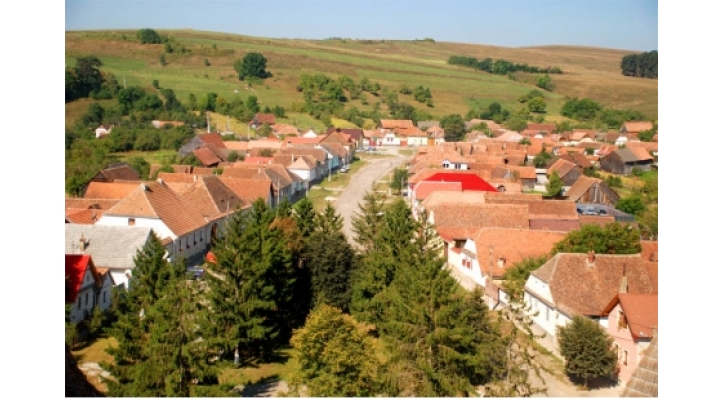The Forgotten Fortress of Homorod
Homorod flies beneath the radar of most visitors on the tourist trail of fortified Saxon churches in southern Transylvania.

The village of Homorod. Photo by Ana A. Negru
Within the triangle between Brasov, Sighisoara and Sibiu are about 150 well preserved fortified Saxon churches from the 13th to the 15th century, out of an original 300.
By climbing the tower in the fortified church you can obtain a good view of the commune and the surrounding farmland and forest. Although the fortress is not generally open to visitors, you can find the key at the town hall next door.
Homorod is a true slice of Romania, with simple houses, farms and dirt roads. Interestingly, upon the outskirts lie some remnants from communist times: old collective farms where the residents of Homorod would have been made to take their animals.
Everyone would have worked on the collective farm and received equal shares in the food and produce regardless of the amount of animals they contributed to the farm.
The church at Homorod is structurally unique compared to others in the area. It is one of the rarest Romanic hall-churches as most Transylvanian Saxon churches were built as basilicas with a nave and two aisles.
Having been restored in 2000, the site is in a good condition and there are plans to open a museum in the courtyard, so perhaps Homorod will soon find its way into the guidebooks.
The only deterrent for visitors might be the slight danger element to climbing the tower. Inside the block structure is a wide expanse with wooden ladders to navigate. Just try to avoid looking down at the huge drops!
At the bottom of the tower are the ruins of the original Catholic church where you can see beautiful frescoes. A later church is attached, which is rarely used nowadays. Just once a month a service is held and earlier this year it was host to a Saxon celebration.
Around the two churches is a fortification wall which houses storage rooms for food and has secret doors and long slits for arrows to be shot out of for defense. The idea was that if the town came under attack, the cattle would be sent into the forest and the residents would run inside the walls of the fortress. Since they never knew when an attack was to occur, meat was constantly stored within the walls and twice a week the people of Homorod would come to cut off slices to eat at home.
According to the caretaker’s mother-in-law who showed us around the fortress, the town was never laid siege to.
As the tale goes, there was a young girl who had a talent for playing the organ and often played inside the church.
The Ottomans were planning a battle, but after one officer heard the music he fell in love with the girl. Never mind that he was 50 and she only 15! It was a happy ever after ending, as the Ottoman officer called off the battle, took the girl and her family to Bucharest and gave them all cushy jobs as teachers.
The old woman then took us around the walls and explained that the school buildings opposite were built in the 1800s.
When we had entered the fortress the children, aged about 10 to 13 years old, were playing outside, showing off and acting very curious about us. They were asking if we spoke English and then pushing each other, giggling. While we were walking around the fortress they snuck in through the open gate and ran up the tower.
When we came around the corner and discovered them, the old woman started yelling at them to get out and they all came running down. They were complaining that they wanted to see the church, that they’d never been inside before.
She told them if they want to visit, they need to get their teacher to bring them, that they cannot come in by themselves.
The children explained that they had been asking their teacher, but he was not interested in bringing them.
It was disappointing that the children were not able to learn about the fascinating history of their own town, especially as they were so keen to find out. In most places it is a huge challenge to engage students in history and culture, and here they are burning with curiousity, clamouring to get into the fortress, yet they are being denied the chance.
But even if they are not able to visit the fortress yet, at least the desire to know about their local history is alive, and when the museum opens they will hopefully have the opportunity to see it with their own eyes, as will the tourists who currently overlook the charms of Homorod.
Text: Allison Jeffares
Photos: Ana A. Negru





